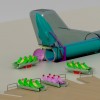Recently, there has been a lot of hype about Elon Musk’s Hyperloop train. Musk, who is no stranger to innovation and entrepreneurship, has also founded
Tesla Motors, PayPal and
SpaceX. The Hyperloop train, a high-speed mode of transportation is his latest venture.
The Hyperloop would use a system of tubes and pods to get people from one place to another faster than ever before. According to
CNN, it would travel twice as fast as the fastest train in the world, the
Maglev. The Maglev train zips on top of a magnetically levitated track at an average 286 mph but has been clocked at speeds slightly over 310 mph.
In other words, the Hyperloop train could potentially travel at records speeds between 600 and 700 mph, according to its creators. How could it travel at such high speeds?
How does it work?
The Hyperloop would have pods, in which passengers sit. Those pods would travel inside of tubes, either underground or above that would utilize low level air pressure. Skis, made of
inconel━an alloy that is resistant to heat and high pressure and primarily made from nickel and chromium with other metals━would be affixed onto the bottom of the pods. Air is pumped through holes in the skis, providing a cushion. Musk has said that the system is, a cross between a, “Concorde, a railgun, and an air hockey table”.
The speed of the Hyperloop relies on low air pressure.
Ars Technica says it would need to be, “1/6 that of the pressure of the atmosphere on Mars or a fraction of a percent of that on Earth.”
Magnetic Acceleration
Air is what speeds the Hyperloop, but magnets are what accelerates it. Super powerful magnets on the skis, along with an electromagnetic pulse will give the pods their initial boost. Instead of using a permanent magnet motor, the system would use a
linear induction motor. Magnets inside the tubes act as the
stator, or the part in a traditional electric motor that do not move. Rotors, the moving part, would be contained inside capsule.
The technology behind the Hyperloop sounds like something from a science-fiction movie, however, it could be a reality soon. The company
Hyperloop Technologies is building a test track in California, and an article in
Mashable says that the test track could be completed and start carrying passengers by 2018. To learn even more details about how the Hyperloop works, check out the
PDF document released by Tesla Motors.
Image by
RichMacf
